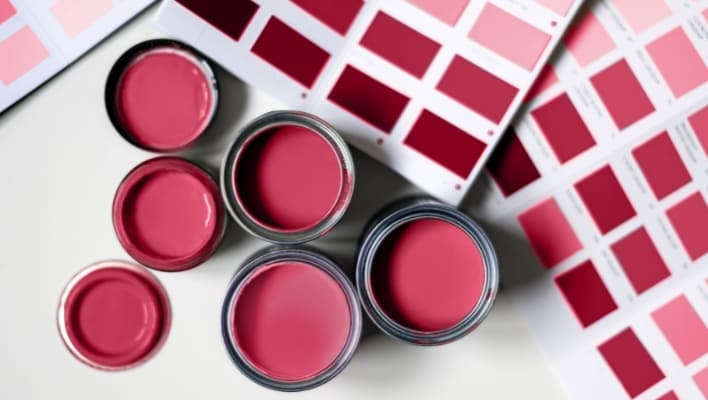If you’ve ever found yourself frustrated with the expense and inconvenience of hiring professionals or struggling with uneven paint application, Best LVLP sprayers offer a cost-effective and efficient alternative. These models minimize overspray and ensure a smooth, professional finish, making them ideal for both homeowner and professional painters in UK, Canada, US or anywhere worldwide. These LVLP spray paint gun not only deliver flawless finishes but also save you time and money.
Before you dive in, just consider factors like the materials you’ll use, how durable the gun is, and how easy it is to clean. To make it easy for you, we’ve checked out the LVLP spray gun scene and picked the best ones to help you paint like a pro.
Table of Contents
- 4 Best LVLP Spray Guns In 2023
- 1. Dynastus Siphon Feed-Best LVLP spray gun for woodworking
- 2. SPRAYIT SP-352 Spray Gun-Best Budget LVLP sprayer
- 3. SPRAYIT SP-33310K Kit-Best LVLP Spray gun for small compressor
- 4. Astro Tool EVOT14 Pneumatic Spray Gun
- How LVLP Sprayers Work?
- Types Of LVLP Sprayers
- Advantages and Disadvantages of LVLP Spray Gun
- How to Choose LVLP Spray Guns for a Smooth Finish
- Budget
- Intended Use
- Nozzle Size
- Air Compressor Compatibility
- Build Quality
- Ease of Cleaning
- Adjustability
- Brand Reputation
- Accessories
- Maintenance and Availability of Parts
- Conclusion On LVLP spray guns
- FAQS On LVLP Sprayer
- What do you use a LVLP spray gun for?
- What size compressor do I need for a LVLP spray gun?
- Is HVLP or LVLP better for woodworking?
- Which is better for automotive paint HVLP or LVLP?
- Can LVLP spray latex?
- Can you spray primer with LVLP?
- Rosalie Sanchez
4 Best LVLP Spray Guns In 2023
- Dynastus Siphon Feed– Best Overall
- SPRAYIT SP-352 Spray Gun– Best Budget
- SPRAYIT SP-33310K– LVLP spray gun kit
- Astro Tool EVOT14 Pneumatic Spray Gun– Best LVLP for base coat, sealer and clear coat
1. Dynastus Siphon Feed-Best LVLP spray gun for woodworking
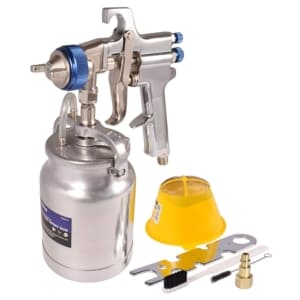
The Dynastus siphon-feed spray gun is a go-to choice for achieving fine finishes, and here’s why:
Its precision-machined air caps and fluid nozzles ensure a high-quality finish. What’s impressive is the separate and adjustable fluid fan pattern, which allows you to achieve precise patterns while minimizing waste.
In the box, you’ll find some handy accessories like an extra spanner, wire brush, handle toothbrush, filter funnel, and a 1/4 NPT quick coupler plug to make your painting job more manageable. I tried to work it with a 3 HP compressor as a pair to get the best results.
This one is great for painting doors or cabinets. With careful use, it can give you a super smooth paint job, but be mindful not to apply too much paint at once.
I really like it because this spray gun handles a wide range of materials, making it suitable for latex paints, enamels, and even glues. However, I wouldn’t recommend using this gun for oil-based paints because the nozzle size is too large (2.5MM). It’s also not suitable for thin materials. However, it works quite well with water-based, thicker paints, as long as you prepare properly.
What I learnt while using this spray gun is that it does not include additional nozzles, which are available with some competing products. So, if you’re just starting out or an experienced pro, make sure not to use too much water when thinning the paint. It can mess up your final result.
This spray gun tends to apply a thicker layer, and if you lack experience, it could result in runs or uneven finishes.
When working with latex paint, it’s essential to thin it properly. Different brands may require varying amounts of water for thinning. To thin your paint properly, start by adding approximately 10% water and mix it thoroughly before use.
I usually avoid adding more than 25% water, as excessive thinning can lead to poor paint adhesion and coverage. You should always test your thinned paint before applying it to a larger surface.
Here’s a personal tip for painting technique: maintain a distance of no more than eight inches from the surface you’re painting. Begin at the top for vertical surfaces and start along the edges for horizontal ones, working your way across. Ensure you fully wet the surface before moving to the next section.
Ensuring a perfect finish is important, and this involves effective paint filtering. It prevents small pieces of dried paint or contaminants from ending up in your spray, which can lead to an imperfect result. So, you should always use an effective paint filter to maintain the quality of your work.
Another reason for choosing this Dynastus spray gun is the hassle-free cleaning process. Unlike my previous airless sprayer, cleaning this spray gun is a straightforward task and is typically completed in just about five minutes. This efficiency is thanks to the anodized internal passages and the polished body of the gun. A convenient cleaning brush set is included with this spray gun, making cleanup a straightforward process.
Remember to clean the gun immediately after each use to prevent clogs that could affect your future projects.
Useful Resource: When considering an air compressor for painting cars, it’s essential to select the right one to ensure a smooth and efficient painting process.
PROS:
CONS:
2. SPRAYIT SP-352 Spray Gun-Best Budget LVLP sprayer
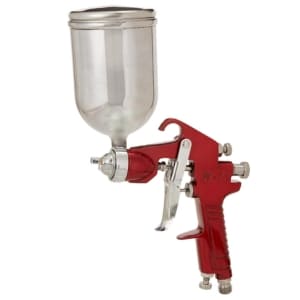
This LVLP paint gun offers great savings, perfect for those on a tight budget. Everyone loves a good deal, don’t you? It operates in the 44-58 PSI range and can handle a maximum of 60 PSI, which means you’ll get smooth and efficient paint application.
I had the chance to use Iwata and this spray gun for painting my car, and I must say I was quite impressed with the results. The gun features a 1.5 mm tip, which works exceptionally well for applying sealer, paint, and clearcoat. Ease of use and cleaning are big pluses in my book.
The feature that truly grabbed my attention was the swivel cup. This feature makes all the difference, especially when you’re trying to reach those tricky spots under the hood, lower areas of the car, or even on the roof. However, there’s a slight drawback I encountered with the swiveling cup. While it’s a useful feature, I found it a bit challenging to tighten securely. On one occasion, as I tilted the paint gun slightly upward, the paint cup unexpectedly swiveled down, resulting in an accidental paint spill. I should note that it could have been my own error, but it seems that no matter how much you attempt to secure it, it tends to remain somewhat loose.
You can even paint the engine compartment without removing the engine, which is a huge time-saver and convenience. Plus, the stainless steel needle ensures no rust or corrosion. That’s a relief!
I’m thinking of purchasing a second one exclusively for thicker materials like sealers. Its performance is that impressive. I found that you can use it for priming paint scratches and possibly as a primer filler, though you might need to add some thinner for the latter. Just keep in mind that extra cleaning might be required if you go that route. For primer filler, I’d recommend a tip size of 1.7 to 1.8 for optimal results.
Helpful guide: Read more about the differences between HVLP and LVLP sprayer and their perfect applications!
PROS:
CONS:
3. SPRAYIT SP-33310K Kit-Best LVLP Spray gun for small compressor
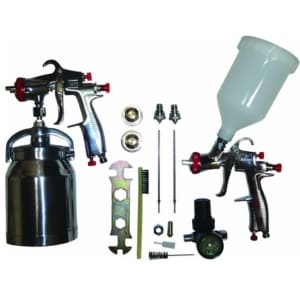
When you need to use two guns simultaneously to complete a project more quickly, this kit works wonders. The SprayIt kit offers two spray guns: the SP-33000 and the SP-31000. They are both one-piece lightweight aluminum guns with different paint cups. The SP-33000 has a 20-ounce plastic cup, while the SP-31000 features a 1-quart metal cup. Both guns allow for adjustable airflow, paint delivery, and fan pattern.
In contrast to the SPRAYIT SP-33000K LVLP kit, which includes 1.3, 1.5, and 1.7mm tips, the SPRAYIT SP-33310K kit comes with four tips ranging from 1.3mm to 2.0mm, as well as essential accessories such as a spanner, brush, socket, and diaphragm regulator. Additionally, it provides an air regulator for convenient pressure monitoring.
One key difference between the two guns is their paint delivery method. The SP-33000 uses gravity feed, while the SP-31000 relies on siphon feed. The latter tends to use more air to achieve the same coverage. However, both guns offer high-quality finishes and work well with lower viscosity paints like lacquer, enamel, stain, and urethane.
Having two paint guns is advantageous, allowing you to switch between colors or materials without frequent cleaning. The kit also includes tools for disassembling the guns for cleaning and maintenance.
It’s important to note that, being budget-friendly, these guns may have parts made of aluminum or plastic that are not as durable as more expensive options. Therefore, handle them with care during assembly and cleaning.
PROS:
CONS:
4. Astro Tool EVOT14 Pneumatic Spray Gun
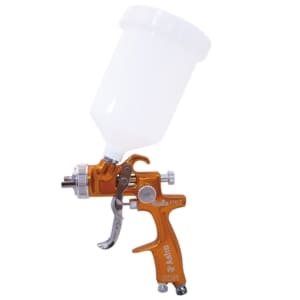
This Astro model is a fantastic choice even for those new to spray painting. I really appreciated how well it fit in my hand. Plus, it’s incredibly lightweight at just 1.8 pounds, which means no more tired wrists or hands during long painting sessions. The soft trigger pull adds to overall comfort, ensuring your hands and fingers stay fresh even during extended use.
The package includes one needle and fluid tip, but you have the option to select between the 1.3 or 1.4-mm models for customization. The stainless steel spray tip and needle, with a diameter of 1.4 mm, are tough enough to handle the knocks and demands of contractor-grade use.
Overspray is a common concern with spray guns, but not with the Astro EVO-T. It incorporates a unique air curtain design that effectively minimizes overspray, while achieving an impressive transfer efficiency of over 80 percent.
This translates to minimal overspray, making it an ideal choice for automotive work where achieving that showroom finish is critical. The gun is built to last, featuring a forged, anodized body that can withstand everyday wear and tear.
Although it comes with a 0.63-quart plastic paint cup, it’s versatile and compatible with various traditional and disposable paint systems.
To operate this spray gun, an air compressor is necessary, but the positive aspect is that it doesn’t demand an extremely powerful compressor.
Make sure to check if your compressor can handle the necessary CFM output for optimal performance.
PROS:
CONS:
How LVLP Sprayers Work?
Low-Volume-Low-Pressure spray guns function based on a unique principle that involves using reduced air pressure and volume compared to traditional spray guns. This design minimizes overspray and enhances control during application.
The core of LVLP operation lies in the atomization process. Paint is drawn into the gun and mixed with low-pressure air, creating a fine spray or mist. This atomization breaks down the paint into small particles, ensuring a smooth and even coating on the surface being painted.
Efficiency is a notable feature of LVLP spray guns. Their low-volume and low-pressure design allows for effective material transfer, meaning more paint reaches the surface and less is wasted in the application process.
In the case of gravity-fed LVLP guns, a paint cup situated on top utilizes gravity to facilitate material flow. Additionally, most LVLP triggers employ a two-stage mechanism. Partially pulling the trigger introduces air, and pulling it further back opens the needle, enabling material to flow. The trigger adjustment allows for control over material flow and atomization, providing versatility in the application.
Compared to High-Volume-Low-Pressure (HVLP) guns, LVLP guns are characterized by larger air passages and slightly smaller holes in their air caps. This design enhances air pressure at the cap, resulting in improved atomization. After understanding these principles, you can easily use LVLP paint guns.
Types Of LVLP Sprayers
| Type of LVLP Spray Gun | Description | Typical Applications |
| Conventional | Standard, versatile for various tasks | Automotive, household projects |
| HVLP/LVLP Conversion Spray Gun | Switches between HVLP and LVLP modes | Versatile for different painting needs |
| Gravity Feed | Paint cup on top, reduces overspray | Smaller tasks, touch-ups |
| Siphon Feed | Paint container below, for larger volumes | Industrial, commercial applications |
| Detail | Precision tool for intricate work | Automotive detailing, hobbies, art |
| Pressure Feed | Requires external pressure source | Heavy-duty industrial applications |
| Touch-Up | Compact, lightweight, precise control | Minor touch-ups, precision work |
Advantages and Disadvantages of LVLP Spray Gun
| Aspect | Why You Should Purchase an LVLP Spray Gun | Disadvantages |
| Efficiency | 1. LVLP guns use less paint, reducing waste. | 1. May require more passes for full coverage. |
| 2. Lower air consumption, saving energy. | 2. Slower application compared to HVLP. | |
| Finish Quality | 1. Provides a fine, even finish. | 1. Not ideal for thick or heavy coatings. |
| 2. Reduced overspray, saving on materials. | 2. Limited for high-gloss finishes. | |
| User friendly | 1. Environmentally friendly due to low overspray. | 1. Initial investment can be high. |
| 2. Complies with strict emission regulations. | 2. Not suitable for all types of paint. | |
| Cost Savings | 1. Reduced paint and air consumption. | 1. Initial cost of LVLP gun may be higher. |
| 2. Saves money on paint and equipment. | 2. Requires a reliable, clean air source. |
How to Choose LVLP Spray Guns for a Smooth Finish
Here are some key factors to keep in mind before buying top quality LVLP sprayers:
Budget
Determine the amount you are willing to spend. LVLP’s are available in various price ranges, so setting a budget will help you narrow down your options.
Intended Use
Think about what you plan to use the spray gun for. Different LVLP guns are designed for various applications, such as automotive painting, woodworking, or DIY project. Make sure that your LVLP sprayer is the perfect fit for your particular needs.
Nozzle Size
The nozzle’s dimensions are crucial in shaping the spray pattern and coverage. Smaller nozzles are well-suited for intricate detail work, while larger nozzles excel at providing broader coverage. Choose a size that aligns with the requirements of your specific project.
Air Compressor Compatibility
LVLP guns depend on a precise air pressure level for effective operation. Ensure that your current air compressor is compatible with the LVLP gun, or be prepared to invest in a suitable one.
Build Quality
When selecting a spray gun, it’s important to seek out models constructed from durable materials. Many users prefer high-quality metal construction for its reputation for longevity and reliability.
Ease of Cleaning
Properly maintaining your spray gun involves regular cleaning. It’s beneficial to consider models that are designed for easy disassembly and cleaning, as this can save you both time and effort.
Adjustability
Examine whether the spray gun offers adjustable settings for air pressure, fluid flow, and pattern control. This level of flexibility empowers you to customize the spray to match the specific requirements of your project.
Brand Reputation
It’s prudent to conduct research on the brand and read reviews to ensure they have a strong reputation for producing dependable LVLP spray paint guns.
Accessories
Some spray guns come with extra features like different nozzle options, extra cups, or carrying cases. Consider what additional accessories may be useful for your projects.
Maintenance and Availability of Parts
Ensure that replacement parts and maintenance kits are readily available for the spray gun. This will extend the tool’s lifespan and save you from unnecessary downtime.
Conclusion On LVLP spray guns
LVLP spray guns offer precision, efficiency, and eco-friendliness, minimizing overspray and waste. They cater to both DIYers and professionals, enhancing finishes and reducing VOC emissions, aligning with sustainability goals. Our recommended choices are the durable Dynastus 33 oz. Siphon Feed Spray Gun and the budget-friendly SPRAYIT SP-352 Gravity Feed Spray Gun, serving a variety of needs. Choose wisely from the options reviewed for your budget and job requirements.
FAQS On LVLP Sprayer
What do you use a LVLP spray gun for?
LVLP guns are more efficient and faster at applying coatings, making them ideal for large projects and high-volume production. They offer controlled, low-volume, low-pressure spraying, making them ideal for detailed work.
What size compressor do I need for a LVLP spray gun?
LVLP sprayer compressor requirements:
You typically need a compressor with a minimum rating of 1.5 HP and a 20-gallon tank for LVLP paint guns. This setup is suitable for smaller-scale projects and occasional use. In contrast, a 2.5 to 3 HP compressor with a larger tank capacity (20 gallons) would be better for larger projects and continuous use.
Is HVLP or LVLP better for woodworking?
HVLP sprayers are usually better for woodworking due to their finer control and reduced overspray.
Which is better for automotive paint HVLP or LVLP?
When it comes to automotive paint, HVLP spray guns are generally preferred. They offer precise control and minimal overspray, making them suitable for achieving a high-quality finish. LVLP paint guns are cost-effective and can be used for auto refinishing, but I would not suggest LVLP gun for car painting.
Can LVLP spray latex?
An LVLP sprayer is suitable for applying latex paint, offering advantages like lower air consumption and compatibility with smaller compressors. It is designed for home use, both indoors and outdoors, making it effective for spraying latex, stains, and varnish. While LVLP excels in clear coats, single-stage enamels, and vehicle painting, it’s noted that HVLP is better for faster application of thinned paints like latex.
Can you spray primer with LVLP?
You can use an LVLP spray paint gun, even one equipped with a 1.8mm nozzle or larger, to effectively apply high build primer. While it’s common practice to reduce pressure when using high-pressure or RP guns for primer application, LVLP guns typically operate at lower pressures, eliminating the need for significant pressure adjustments. Moreover, thinning the primer slightly can enhance its sprayability.

Rosalie Sanchez
DIY enthusiast with years of experience in home decor and home improvement. With a passion for educating consumers about DIY projects. Every time, I work with our painting professionals to provide you with the best painting product reviews and how-to advice. You can follow me on Facebook.


